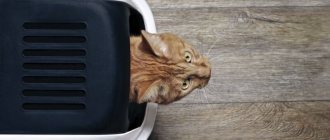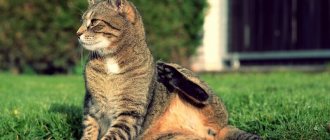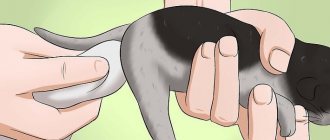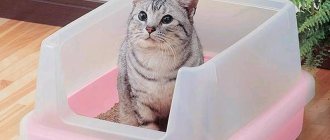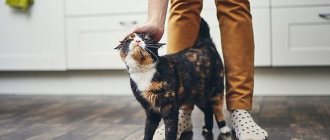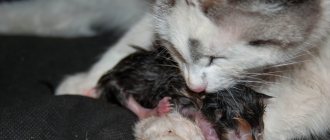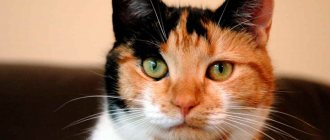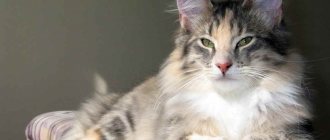When bringing a cat into the house, people should be prepared for the fact that it will have to be toilet trained. However, cats do not always fulfill their needs the way their owner would like. But the reason is not always the stubbornness of the animal, because it may simply have problems with urination or defecation.
To prevent difficulties in managing your needs from leading to even more serious problems, you need to contact a veterinarian in time to help find out the root cause. If a cat does not go to the toilet for more than a day, this can lead to blood problems and kidney failure. In this article, you can learn about the main reasons why your pet may have difficulty going to the toilet.
You can learn a lot about your cat's health from her feces. In most cats, the frequency of elimination is at least once (1-2 times is considered normal) times a day. Typically, the stool should look well-formed and brown in color, but it may look slightly different. If your cat defecates less frequently and has difficulty doing so, she is constipated.
Free consultation Moscow
+7(495)162-70-70
Problems with going to the toilet in general
Typically, kittens at the age of one month can go to the toilet to relieve their great needs from 3 to 5-6 times a day. The main factors that can cause problems going to the toilet in general include the following:
- The cat's inability to cope with her responsibilities of toilet training her newborn kitten. It is the cat who must ensure that the baby can relieve his natural needs.
- Another cause of problems may be a congenital pathology, for which you should immediately contact a veterinarian.
- A small kitten should transition very smoothly from mother's milk to adult food. If the transition occurred abruptly, then this can cause major hiking problems.
- Stress when changing the environment can also be the reason when a kitten refuses to walk for several days. It is necessary to sound the alarm when adaptation has passed, which is about 5 days, and the problem with the toilet has not been resolved.
Feline megacolon is an intestinal disorder that results in chronic and progressive constipation. The disease may be caused by damage to the nerves of the intestine or impaired functioning of the smooth muscles of the colon.
The size of the stool can increase to the diameter of the colon, which makes it difficult for the resulting stool to pass through the bony canal of the pelvis, which does not increase in size and, as a result, defecation becomes impossible. When this happens, the colon is affected and serious secondary problems can occur.
Prevention
Chronic diseases of the urinary system require careful monitoring. It is important to find a competent doctor who will develop an individual scheme and will thoughtfully adjust it as changes occur. The general approach with one prescription for all in the case of cystitis, urolithiasis and PN is disastrous.
Prevention of exacerbations is comprehensive:
- strictly follow the instructions without experimenting with medications;
- Together with your doctor, choose a diet or medicinal food with mandatory monitoring of blood and urine readings. No salt, fish, fat, excess meat;
- Filtered water should always be available - several bowls throughout the apartment. If the cat does not drink, switch to a semi-liquid diet;
- control the load - the pet should not sleep all the time, but too active games are contraindicated for it;
- avoid overheating, hypothermia, stress, injuries;
- take tests, ultrasound, x-rays every six months.
A filler that responds to changes in urine acidity will help control your pet’s condition. If you suspect a relapse, consult a doctor immediately. With each attack when the cat cannot pee, it will be more difficult to restore the functioning of the genitourinary system, so you should not lead the situation to urinary retention.
Symptoms of feline megacolon
- Straining during bowel movements with little or no stool volume
- Small, hard and dry feces
- Infrequent or complete absence of bowel movements
- A small amount of loose stool with mucus – sometimes with blood – that occurs after prolonged straining before defecation (tenesmus)
- Periodic vomiting
- Lack of appetite
- Depression
- The colon is filled with hard, compacted fecal material
- Swelling around the anus
Causes of feline megacolon
Behavior and lifestyle
- Foreign material (swallowed bones, swallowed hair)
- Excess fiber in the diet
- Lack of exercise
- Stress (the problem of having several cats, change of environment, hospitalization, moving, dirty litter box)
- Intestinal obstruction
Pain
- Trauma, joint disease, pain as a symptom of disease
Dehydration (insufficient water intake)
And although cats are desert animals by nature, their modern relatives need free access to water for the normal functioning of all body systems. And if for some reason there is a violation of the hydrobalance (for example, with kidney disease), then the water necessary for the formation of feces begins to be absorbed in the colon, as a result of which they form hard and dry.
Metabolic disorders
- Obesity
- Low blood calcium levels
- High levels of parathyroid hormone (important for calcium absorption)
- Low blood potassium levels
- Low levels of thyroid hormone in the blood
Neurological problems
- Paralysis/muscle weakness (intestinal muscles cannot move feces)
Colon obstruction
- Pelvic deformities (eg, healed pelvic fracture after injury)
- Tumor
Idiopathic megacolon
Megacolon can also occur in a cat as a primary condition without an obvious underlying cause. In this disease, a problem develops in the muscles of the colon wall itself, resulting in a progressive inability to contract.
Emergency care for a cat with constipation.
If your cat has not used the litter box for more than 24 hours or is passing a small amount of feces each day:
- Make sure your cat has free access to water and drinks it.
- Feed her wet canned food.
- Try adding a tablespoon of canned pumpkin to your canned goods.
- If constipation lasts more than 48 hours, your cat needs veterinary attention.
- An alternative to pumpkin is a laxative (such as Metamucil®). Check with your veterinarian for dosage.
- If dietary changes (such as increasing fiber and water intake) do not help, your veterinarian will likely give your cat an enema.
Call a veterinarian Moscow
+7(495)162-70-70
An adult cat does not relieve itself to a large extent
Adult cats and cats, unlike kittens, can go to the toilet only once a day. The owner should only worry if the animal has not been able to walk for more than 3 days. Common reasons for the absence of bowel movements in adult felines are:
- Incorrect nutrition and incorrect ratio of nutrients. Stool may be retained due to insufficient fluid intake, as well as low fiber intake.
- Moving or having guests can also affect problems with going to the toilet.
- A cat may not go to the toilet if a new animal has appeared in the apartment.
- Cats clean their fur using their tongue, so there is a possibility that hairballs may form in the gastrointestinal tract. Their presence also causes problems with going to the toilet in general.
- Neutered cats usually lead a sedentary lifestyle, which leads to obesity. But obesity itself can lead to problems with bowel movements.
- The age of a cat greatly affects trips to the toilet, since the intestines of an old cat can no longer move feces through the intestines quickly enough.
- If an adult cat has difficulty going to the toilet in general, it is necessary to check its internal organs.
Description
Cats are light-drinking animals.
They go without water for several days, obtaining moisture from urine. They can endure for a long time without visiting the litter box due to stress, unpleasant odor or new litter. But the concentration of urine is constantly growing. Coupled with a sedentary lifestyle, these factors make the urinary system a weak point in cats. The kidneys continuously cleanse the blood of toxins, are responsible for the acid-base balance, participate in metabolism, and perform an endocrine function. A healthy cat pees at least three times a day, getting rid of salts and protein breakdown products. Fresh urine has almost no odor, is light and transparent.
The condition when a cat cannot pee leads to serious consequences for the body:
- urine goes out - intoxication increases;
- water, acid-base balance is disturbed;
- with increasing urine concentration, the walls of the bladder are damaged;
- bacteria are not washed out of the urethra, reproduction leads to ascending infections;
- Within a day, azotemia develops - the accumulation of metabolic products in the blood. This is an emergency condition in which 10% of patients die even in a hospital setting;
There are two options for urinary retention. With kidney failure, urine is not produced. With obstruction, the cat cannot pee due to a “plug” in the ureter, bladder neck or urethra. That is, the cat either has nothing to pee with, or urine cannot come out due to an obstruction. The urethra of cats is wider and shorter, so they are less likely to suffer from blockage than cats.
Treatment of constipation in cats
Laxatives
There are many laxatives available now, although many are not licensed specifically for cats.
- Emollient laxatives.
Drugs that help retain fluid in cat stool, thereby making it softer. These laxatives have a weak effect, but can be useful, either alone or in combination with other medications.
- Osmotic laxatives.
They retain water, soften and increase the volume of contents in the cat’s intestines. They are distinguished by their powerful action. Used alone and in combination with other laxatives.
- Stimulant laxatives. Some medications have the effect of stimulating the contraction of the muscles in the walls of the cat's colon, which helps move feces toward the anus. These medications work in a variety of ways and are only safe for short-term use.
Prokinetics
Prokinetics are medications that stimulate the motility of the cat's gastrointestinal tract. Like stimulant laxatives, they help enhance neuromuscular control of colon contractions. Prokinetic agents can be used long-term, usually in combination with other measures to control constipation (eg, lactulose and dietary foods).
Surgical operations
If drug therapy does not provide results in combating constipation in a cat, it is sometimes necessary to perform an operation such as a subtotal colectomy - removal of most of the colon. Although this is a fairly serious operation and your cat will inevitably have diarrhea for some time afterwards, the long-term outcome of the operation is often very good. Most cats adapt gradually and the diarrhea goes away fairly quickly.
Preventing constipation in cats
- Ensuring good hydration
- Diet
- Physical activity
- Use of intermittent emollient laxatives
- Controlling the number of bowel movements per day/week
Problems with going to the toilet in small ways
It is very easy for the owner to understand that the cat is having problems going to the toilet in small ways. In such cases, cats begin to behave very noisily. The animal may meow loudly, stomp around the tray, but not sit in it, and they cannot lie on their stomach because of the painful sensations in it. If a cat tries to go into the litter box, but fails, traces of blood and even pus can be found in it. Some of the common reasons why an animal cannot go to bed are:
- A small amount of fluid intake, which leads to the formation of stones.
- Hereditary predisposition, for example, when someone in the cat’s family already had problems with going to the toilet.
- A common reason for the inability to go to the toilet normally is poor nutrition, for example, when the animal does not have enough nutrients in the body or if the owner feeds the animal raw meat and fish.
- Urine can be very poorly excreted in cats that lead a sedentary lifestyle and are overweight.
- A cat may have problems urinating if it has a new owner or has moved to a new place and is under extreme stress.
- When an animal has a pathology of the urinary tract, it is necessary to urgently seek help from a veterinarian; in rare cases, surgical intervention may be required.
- Constant consumption of dry food can cause urolithiasis, so it is very important that your pet has constant access to fresh drinking water.
How can I help the animal?
You should not take any measures on your own to help your cat empty his bowels or bladder. Any medications should only be prescribed by a veterinarian, after determining the cause of urinary or fecal retention.
For example, laxatives should not be given for tumors, adhesions, intestinal obstruction, or the presence of foreign objects in the gastrointestinal tract. Otherwise, such treatment may lead to rupture of internal organs.
If the veterinarian has allowed the use of laxatives, then it is advisable to choose softer ones - Duflac or Vaseline oil. If you have constipation, you should not give your cat castor oil. This oil will cause increased pain and worsening of the condition.
The doctor must prescribe medications that restore intestinal microflora, enemas, anti-inflammatory and painkillers. During treatment, the cat is given more liquid and less dry food. Infusions of medicinal herbs are poured into the animal's mouth.
If a hot bath is needed, the cat is lowered into it only to the level of the heart. In any case, it is better to carry out all procedures, injections and treatment in the clinic. Some pathologies of the urinary tract become chronic. In this case, treatment should be carried out regularly. Herbs are given to the cat over a long period.
Cat sterilization and toilet problems
Sterilization is a fairly quick operation, but it requires a long recovery. In the period after surgery, it is very important to monitor your pet’s sutures, treat them in a timely manner and remove them only by a veterinarian. If during the postoperative period the cat does not go to the toilet, constipation must be ruled out. Urination may be in small quantities, which will be completely unnoticeable to the owner. In order to prevent strong pressure on the abdominal wall, which can lead to suture divergence, you should offer the animal only soft and gentle food.
Sometimes the anesthesia used during surgery negatively affects the animal's condition and can lead to constipation. It is quite easy to understand whether an animal has constipation. At this time, the cat does not want to go to the litter box, meows often, there is no bowel movement, and there is a complete refusal to eat. Even during this period, you can observe how the animal’s tail shakes slightly and the seam may be damaged. If constipation does occur, then you need to contact a veterinarian who will prescribe special medications and a balanced diet. If it is not possible to contact a specialist, you can try to alleviate the animal’s condition with a tablespoon of Vaseline.
Often the cause of urinary retention is the stress that the animal experiences during and after surgery. Also, the blanket can bring them significant discomfort.
In this case, you can carefully remove it, after consulting with a doctor, and then watch to ensure that the cat does not lick the seam area.
Therapeutic diet
Natural cats are put on a low-calorie diet that excludes the consumption of fatty meat, fish and milk. The list of permitted foods depends on the acidity level (pH). At a high value, oxidizing products are used (liver, veal, egg whites, boiled fish, chicken), and at a low value, alkalizing products are used (spinach, carrots, broccoli, egg yolks, fresh cottage cheese).
A sick pet eating dry food is transferred to a treatment line for animals with urinary dysfunction. Such nutrition reduces the load on the liver, destroys stones and normalizes urine output.
Childbirth and problems going to the toilet
Before giving birth, cats begin to prepare their bodies for childbirth. So, just before giving birth, they stop eating a lot or refuse to eat at all, and also begin to go to the toilet more often. After giving birth, a cat may not walk for about 24 hours, and avoid bowel movements for 3 days.
When a cat begins nursing kittens, she loses a lot of fluid, so it is very important to replace lost fluid. If your cat doesn't drink enough water, this can lead to constipation. To help your pet get rid of constipation, you can offer him a small amount of olive oil. If, even after 24 hours after using olive oil, the cat still does not go away, then you should seek help from a specialist.
For any living creature it is very important not only to drink and eat, but also to cope with its natural needs. If your pet does not walk on small or large for a long time, then you should contact a veterinarian. You need to pay attention to the cat already on the second day, if during this time the animal was not noticed urinating. The veterinarian will definitely find out the cause of constipation or problems with urination, and will also ask questions regarding the pet’s diet, drinking regime and how long he has had problems going to the toilet.
Diagnostics
If the general condition allows, an ultrasound and x-ray of the abdominal cavity are performed on the day of treatment. Urgently do a general blood and urine test and biochemistry. The results show how damaged the kidneys are, the level of intoxication, the condition of the liver, and the degree of dehydration.
If urolithiasis is suspected, the acidity of the urine and the type of stones are determined in order to combat the problem in a targeted manner. For cystitis, it is advisable to take a smear for infection. Additional tests (extended biochemistry of blood, urine) are necessary when it comes to PN. It is important to talk about the volume and color of the discharge, how many hours the cat cannot pee, whether there is blood, vomiting, or thirst.
